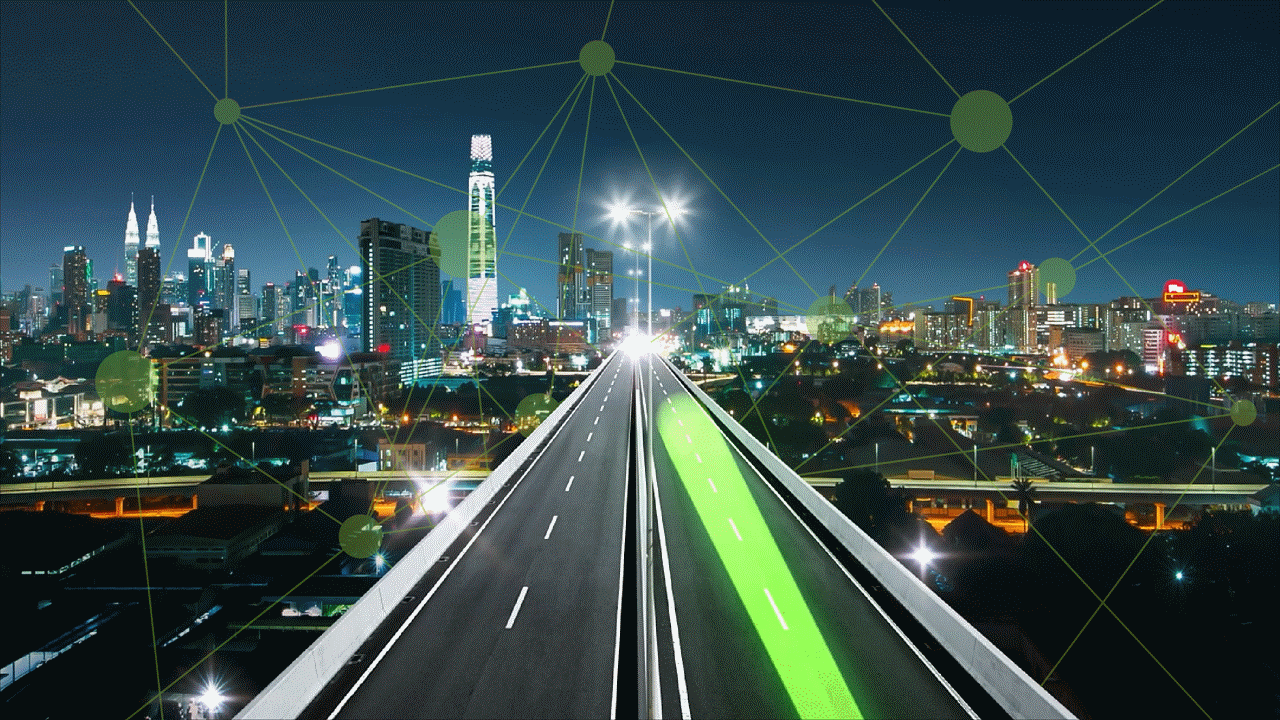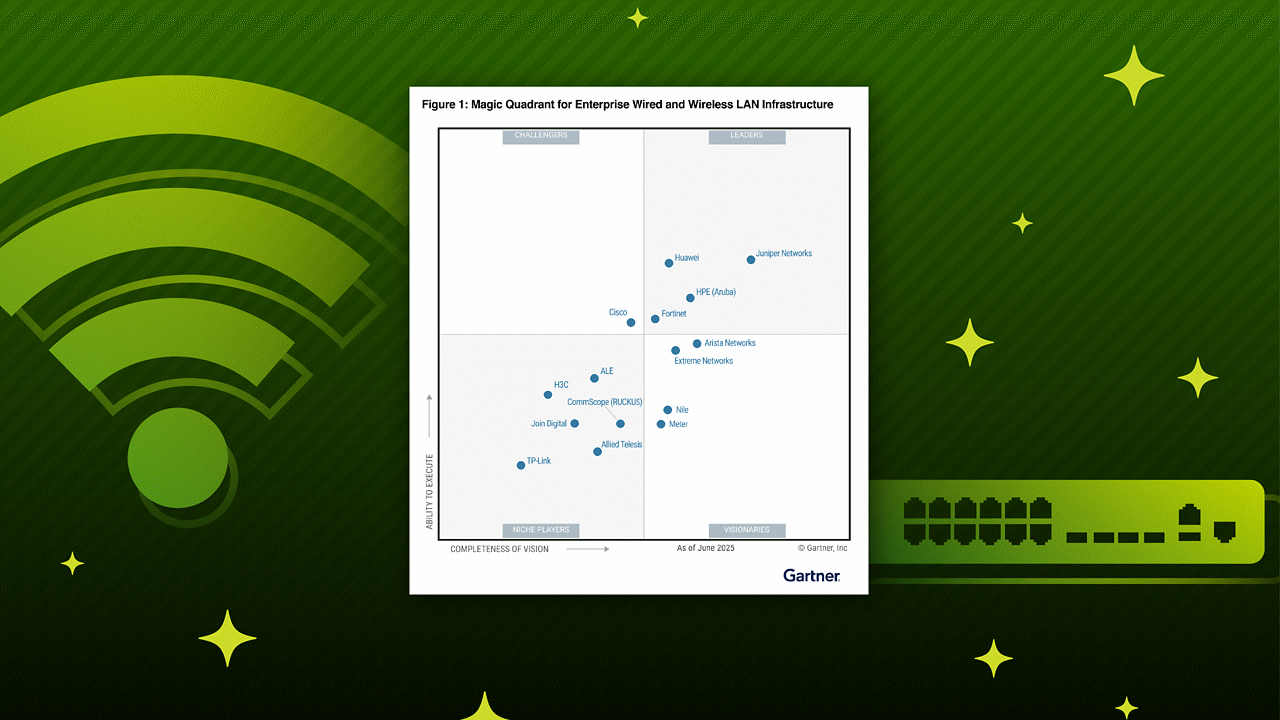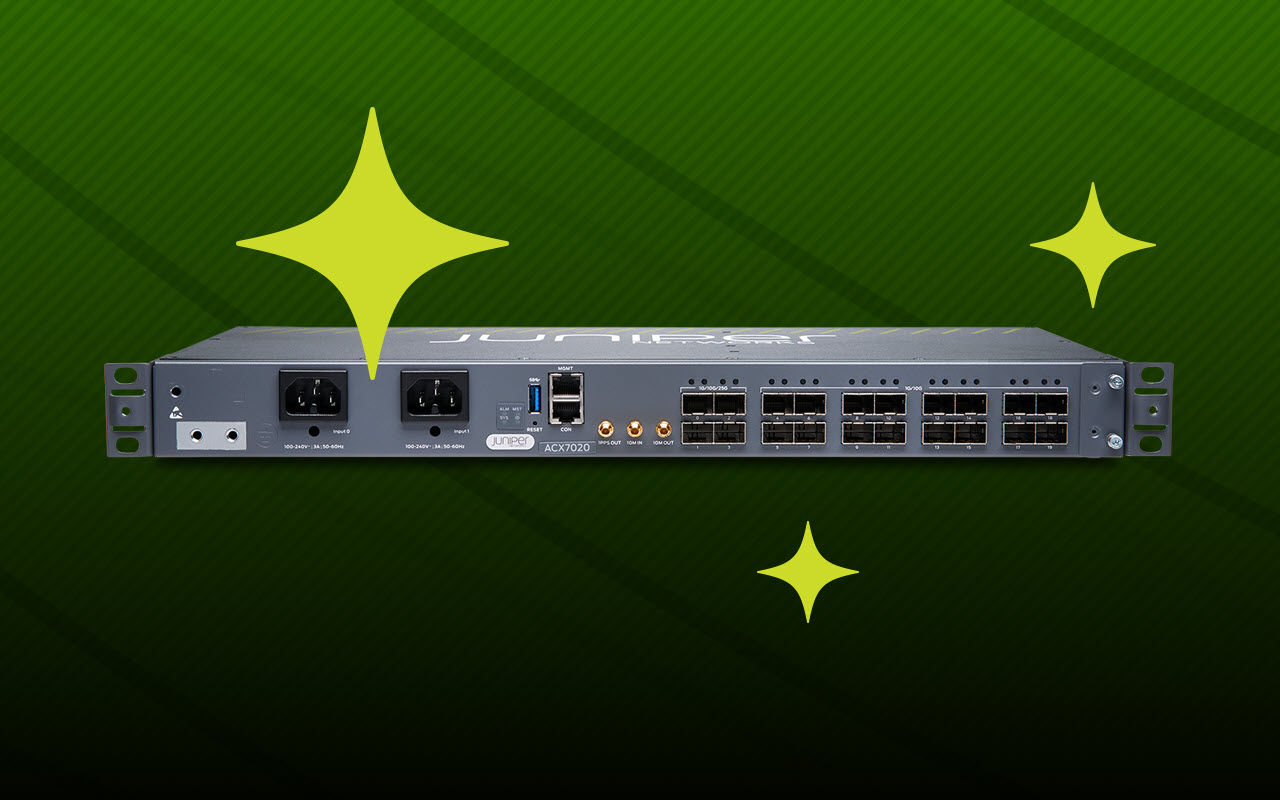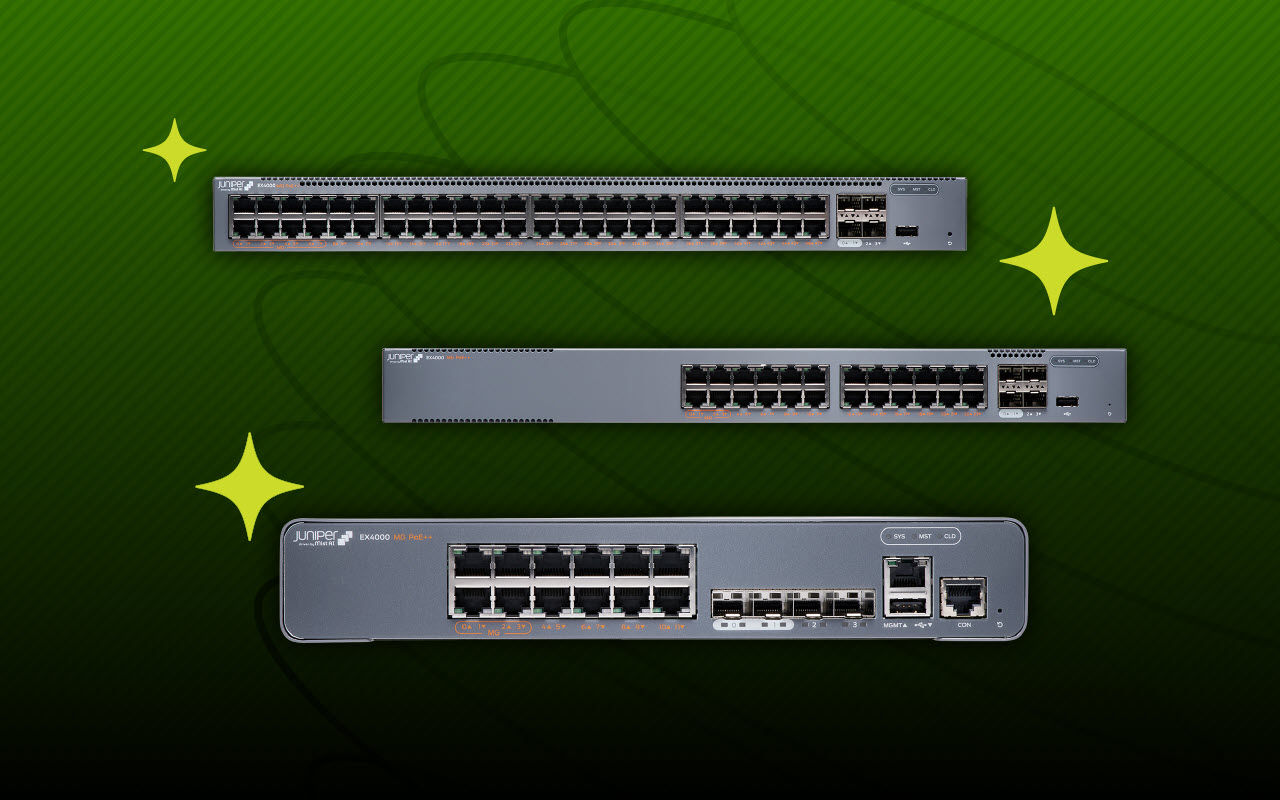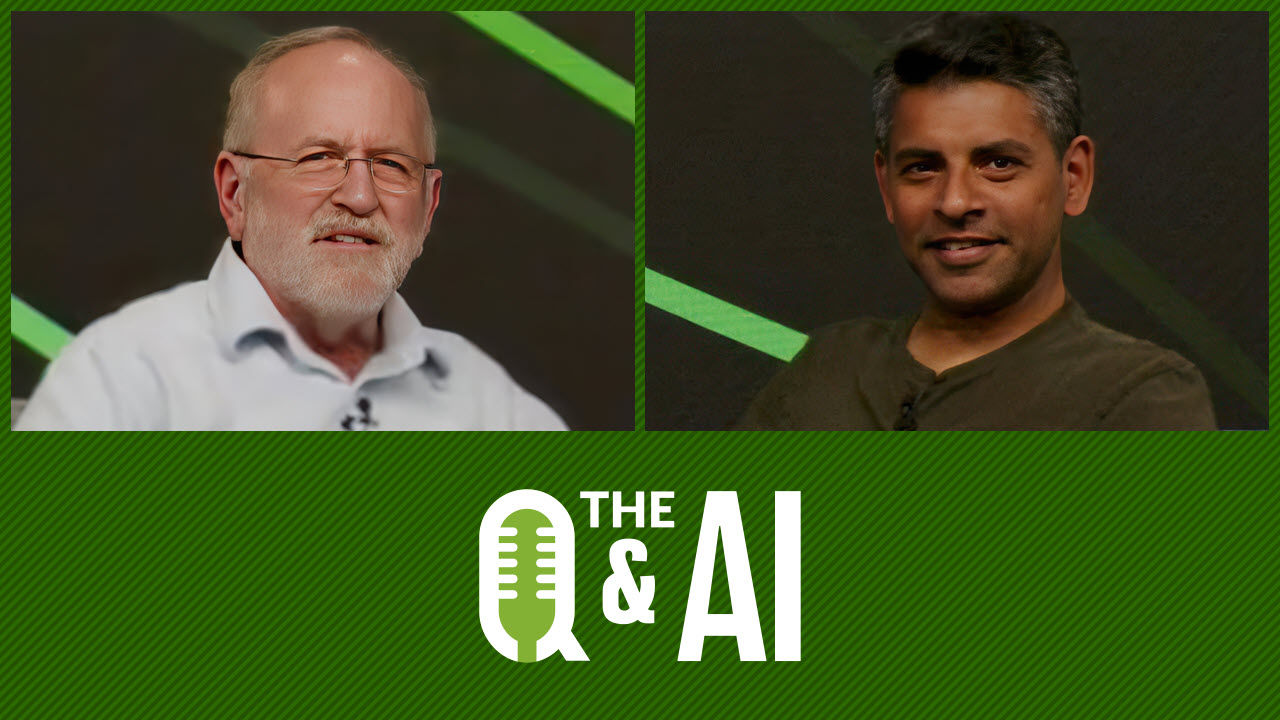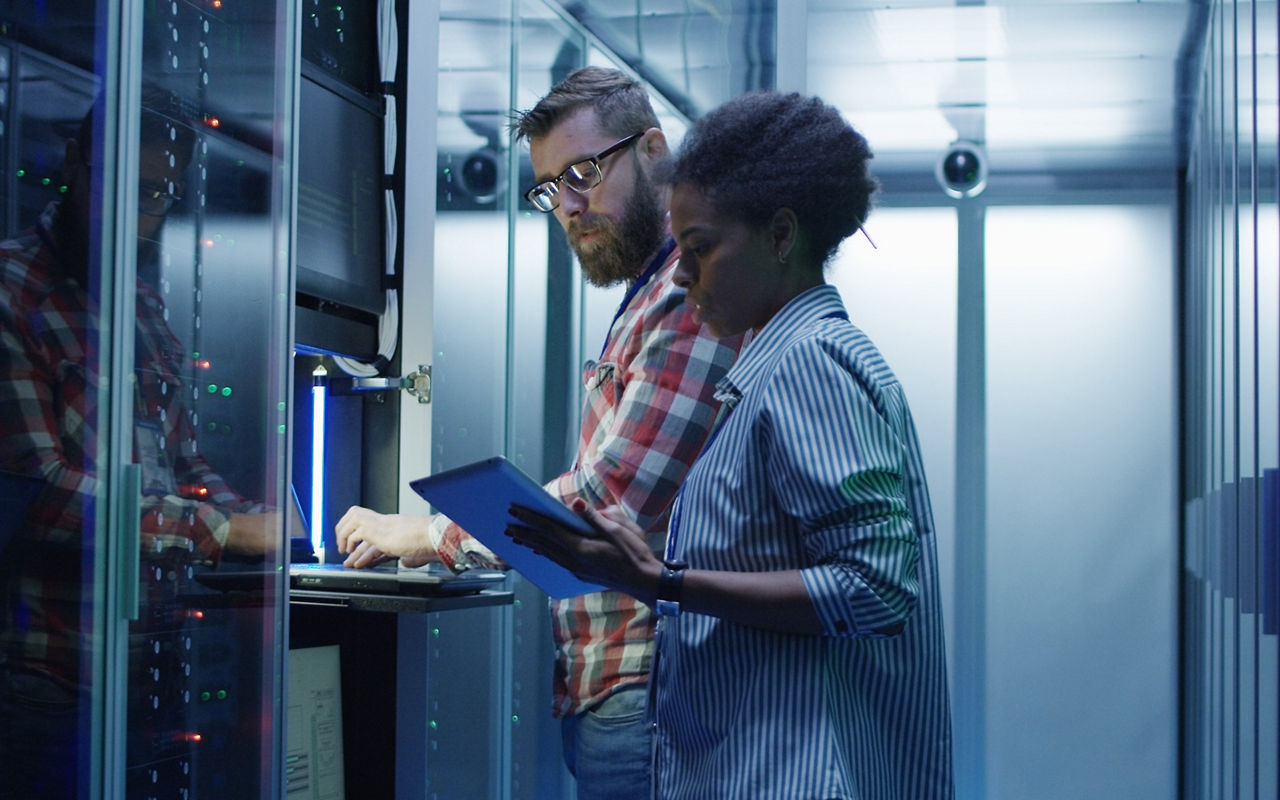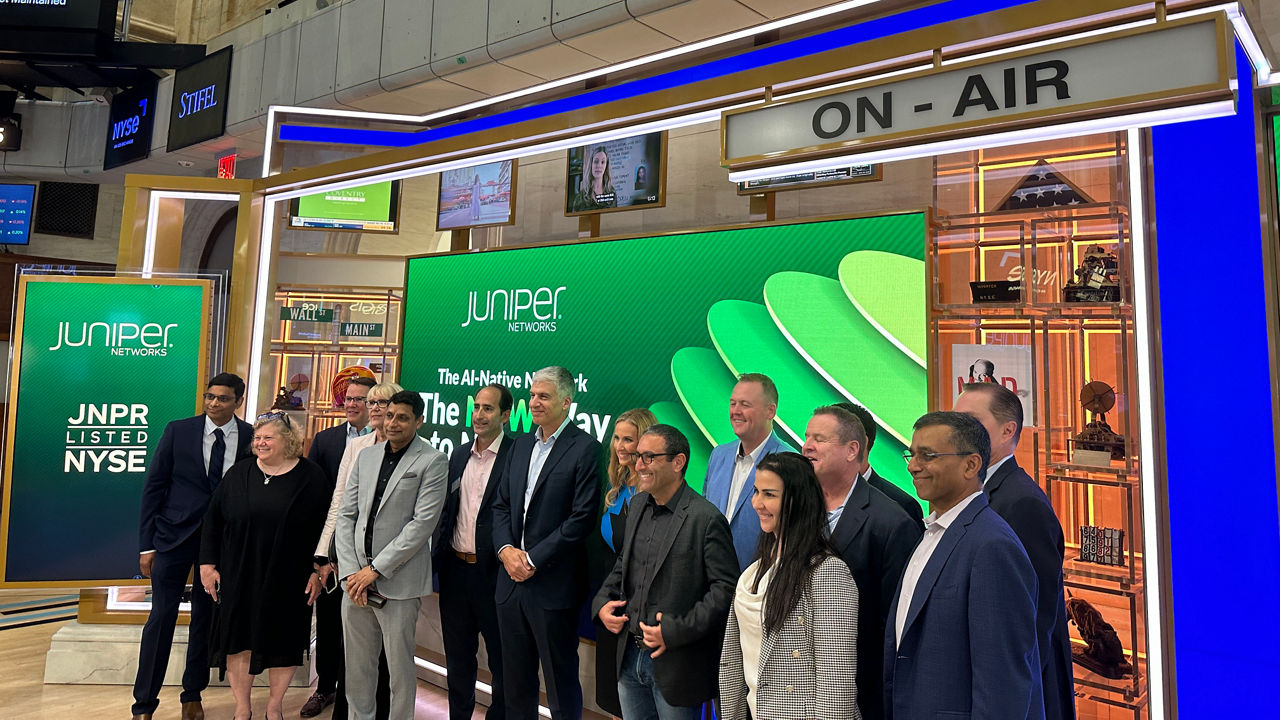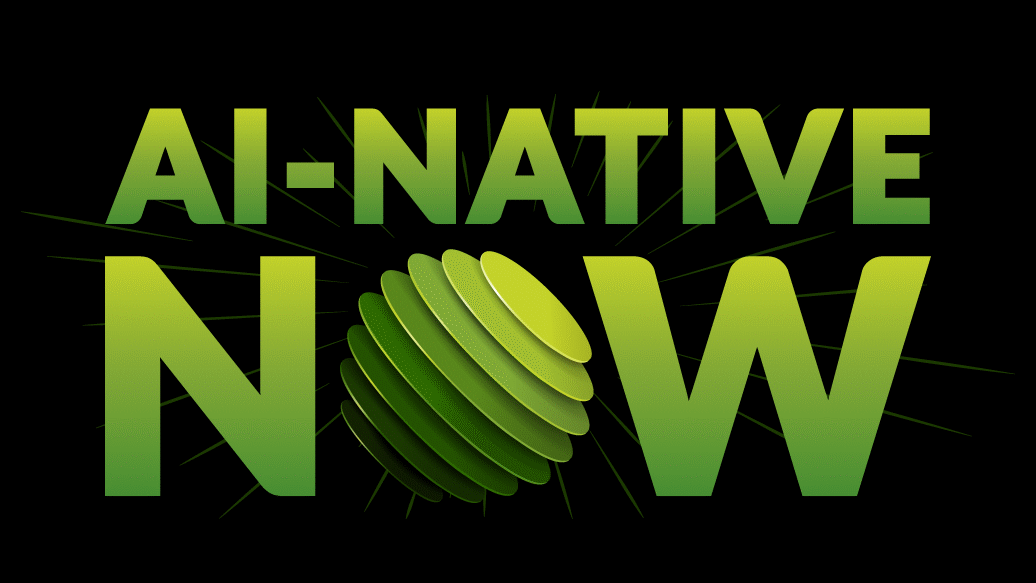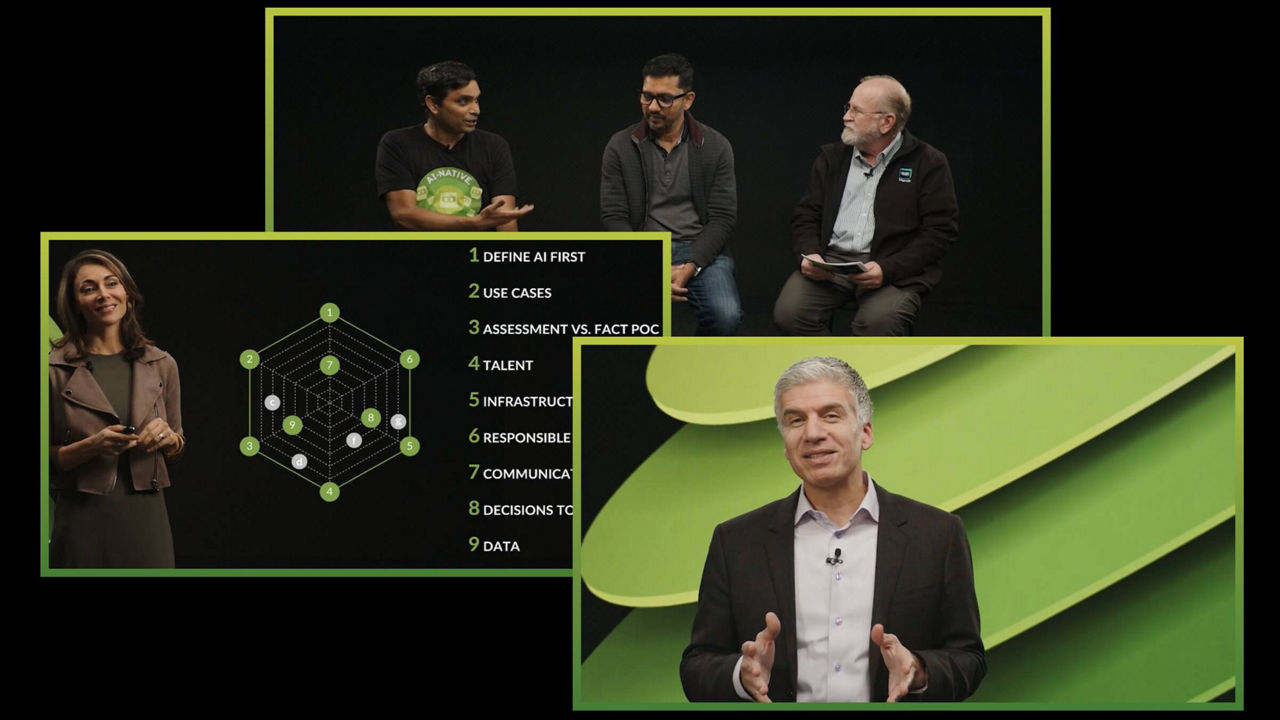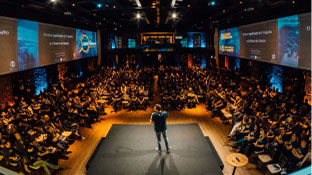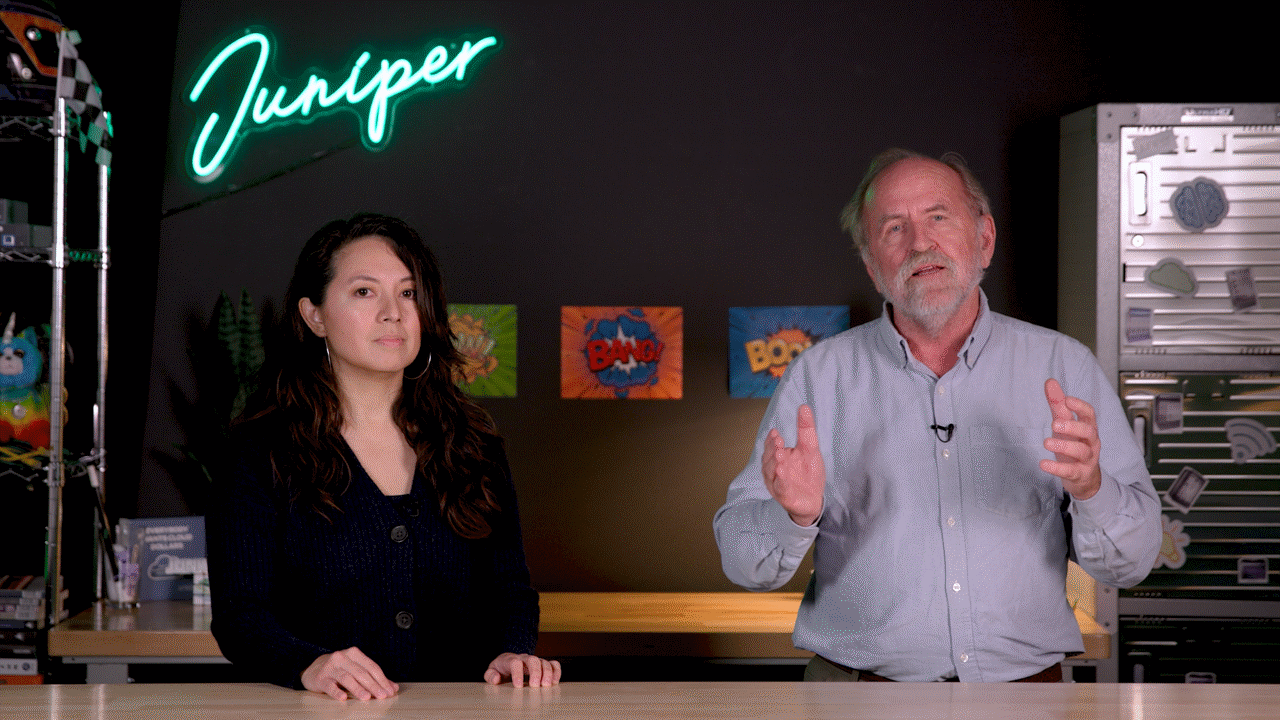AI Slop Is Everywhere

NetworkChuck: Would you put AI in your Network?
NetworkChuck contrasts AI products from Cisco with Mist™, our AI-native networking platform, discusses the differences in architecture, and shares what a robust AI platform can do for networking.
You’ll learn
The difference between a new “AI” product for networking and one with ten years of deep data and training
How Mist takes a different approach to training AI infrastructure
Insights from Juniper customers and partners
Who is this for?
Experience More
Transcript
0:00 AI enabled, AI powered, AIdriven, AI
0:02 enhanced, AI slot. I'm getting tired of
0:05 this. This is what we're seeing with
0:06 every product we use since Chat GBT
0:08 broke everything in 2022. Now that
0:11 marketing's got a hold of it, you know,
0:12 is it AI? Is it glittery machine
0:14 learning? Thank you, Alan. Yes, every
0:17 industry, including networking, is
0:18 slapping on that AI sticker because
0:20 that's all investors care about right
0:21 now. Everyone's jumping on this AI hype
0:24 train, and I want to get off. I mean,
0:27 come on. Is adding AI to all of our
0:28 products actually solving real problems?
0:31 Is it making us better? And specifically
0:33 for IT and network engineers, are we
0:34 seeing real results? That's what I want
0:36 to figure out in this video. Is this all
0:38 just AI slop? Or are there real use
0:40 cases? Like, as a former network
0:41 engineer, I want to see this happen.
0:43 Maybe the network is up all the time.
0:45 Maybe I don't receive a call at 3:00
0:47 a.m. And while AI is kind of scary for
0:49 the job market, we're also kind of
0:50 begging for the things it's promising
0:52 us, like this Reddit post here. Where is
0:54 all this AI ops stuff that's supposed to
0:56 help us? But first, get your coffee
0:57 ready. This is a journey. And my journey
0:59 begins by attending the largest
1:01 networking conference in the world,
1:02 Cisco Live. With over 22,000 people, I
1:05 thought, surely I can find an answer.
1:07 But what's funny is the interesting
1:08 story didn't actually happen there.
1:10 About a mile and a half away, 10
1:12 minutes, another event was held by
1:14 another large networking vendor, Juniper
1:16 Networks. Now, Juniper heard I was going
1:18 to Cisco Live and they said, "Hey, shut
1:20 you know all this AI stuff people are
1:21 talking about, we're actually doing it
1:23 and we want to show it to you." They
1:24 also said something about making
1:25 networking sexy again. Now, it's no
1:27 wonder that networking has become sexy
1:30 again. So, I'm like, "All right, let's
1:32 do this." But seriously, thank you to
1:34 Juniper for inviting me to their event
1:35 and helping make this video possible. By
1:37 the way, this video was made prior to
1:39 the recent news about the HPE
1:41 acquisition of Juniper. You can check
1:42 out the links to the press releases, but
1:44 I just wanted to give you that bit of
1:45 context before we continue. All right,
1:47 let's take a quick coffee break.
1:50 And here we go. I arrive at the Juniper
1:53 event just after Cisco announced all
1:55 their major AI stuff. So AI was already
1:58 kind of top of mind and I'm like man
2:00 how's Juniper going to beat this? But
2:01 then Sudhir said this today across the
2:03 street you heard a lot of announcements
2:06 AI canvas AI this agentic AI all kinds
2:09 of stuff. We are not confused about what
2:12 we are trying to build and who we are
2:14 trying to be. We are trying to build the
2:17 industry's first self-driving network.
2:20 Period. end the story. So I was like,
2:22 okay, they're not worried. They're not
2:24 scared. But then I heard something
2:25 crazy. Rammy, their CEO, said, "We've
2:28 been leading the AI and network
2:30 convergence for more than 10 years now."
2:34 Uh, excuse me, sir. Chat GBT came out in
2:37 November 2022. There was no AI before
2:39 that, right? That is kind of how it
2:41 feels, but AI was very much a thing
2:43 before Chat GBT. Back then in the early
2:45 to mid2010s, it was not about generative
2:48 text or chat interfaces. It was about
2:50 machine learning and it was more about
2:52 being very focused at being good at one
2:54 thing so it could find patterns and data
2:56 make predictions and decisions and
2:57 that's exactly what the founders of Miss
2:59 Networks did. Miss Networks, who's that?
3:01 I'll make a connection. Don't worry,
3:02 it's coming. The founders, Sujay Hija,
3:04 Bob Friday, which is an awesome name,
3:06 sounds made up, and Brett Galloway, all
3:08 former Cisco employees by the way,
3:10 founded Miss Systems in 2014. Uh, we
3:12 were responsible for Cisco's wireless
3:14 business. We did the acquisition of
3:16 Moroi in December of 2012 and it
3:20 inspired uh the creation of Mist with
3:23 the goal of reinventing enterprise Wi-Fi
3:25 with cloud computing powered by
3:27 artificial intelligence AI. And this is
3:30 2014. Now the main difference with their
3:32 AI versus what we see now is that it was
3:34 trained very specifically on wireless
3:37 LAN data. What a good network looks
3:38 like, what a bad one looks like, how to
3:40 troubleshoot things. Very specialized.
3:42 You couldn't ask it how many Rs were in
3:44 strawberry. They didn't care about that.
3:45 All it cared about was Wi-Fi. They
3:47 coined the concepts AI for IT or AI is
3:50 in the air. Kind of cheesy, but I like
3:52 it. And tell me if this sounds familiar.
3:54 They wanted to deliver a self-driving
3:55 network. One that could proactively
3:57 detect and adapt to issues in real time,
3:59 saving it teams money and time. Kind of
4:01 sounds like what we're talking about
4:02 with AI now, except this was over 10
4:04 years ago. Now, were they successful?
4:07 Um, yeah. They were purchased by Juniper
4:09 in 2019 for $45 million. See the
4:13 connections made now. This became part
4:14 of Juniper and Juniper's like, "I love
4:16 your AI stuff. Let's make it part of all
4:18 that we're doing." Now, think about that
4:19 for a second. Juniper has had AI in
4:21 their portfolio, their stuff since 2019,
4:24 miss system since 2014. The thing I'm
4:27 wondering is, does that matter? Like,
4:28 for what we have now, does that 10-year
4:30 head start make a difference? That's
4:32 what I want to figure out. Now, one of
4:33 the co-founders, Bob Friday, again,
4:35 amazing name, said this about grapes or
4:38 AI. I make a barrel of wine. I always
4:40 tell people, you know, great wine starts
4:42 with great grapes. You know, AI has the
4:44 data. So, it's like getting getting your
4:46 arms around the data is usually the
4:47 first step on the journey to mastering
4:49 AI. Now, one thing I've learned about AI
4:51 so far is that it all depends on the
4:53 data you feed it, the context you
4:55 provide. This is true across the board
4:57 for anything. You can ask an AI like
4:58 ChatB. Hey, what should I have for
5:00 dinner tonight? And it might say
5:01 Hawaiian Sunrise Pizza with pineapples
5:03 and cashews. Perfectly fine answer. But
5:05 it may not have the context of you that
5:06 you might hate pineapples and you're
5:07 allergic to nuts. Context and data is so
5:10 important for AI. In the same way, we
5:12 can't ask an LLM about our network
5:13 unless it has the context of our
5:15 network. So, how are we giving it that
5:17 context? How is it learning about our
5:18 vast, massive, complex networks? Well,
5:21 what we're seeing right now is a lot of
5:22 bolt-on AI again slapping that sticker
5:25 on. We're feeding our LLMs a ton of data
5:27 about our network, telemetry data from
5:29 our routers and switches, packet
5:31 captures, and just everything. Here you
5:32 go, friend. Figure it out for me,
5:35 please. And that's kind of what we're
5:37 seeing with vendors like Cisco. Now, I'm
5:38 going to pick on Cisco first because
5:39 they are one of the largest networking
5:41 vendors. No hate, I love Cisco. But
5:43 right now, they have a lot of things to
5:44 pull data from. They've got thousand
5:46 eyes, which when you really think about
5:47 it is a scary, scary name for something.
5:50 Makes me think of one of those angels
5:51 from Revelation. You know what I'm
5:54 talking about. It's watching you. And
5:55 they use it for monitoring their network
5:57 stuff. So, they're getting telemetry
5:58 from that. They also have Splunk,
6:00 Catalyst Center, App Dynamics. Now, it's
6:02 not important for you to know what all
6:03 these are. I just want to point out that
6:04 they have a lot of things, a lot of data
6:06 pouring into an LLM. And while they do
6:08 have this really neat DPM or deep
6:10 network model, specially trained on all
6:12 their networking stuff, they are relying
6:14 on its ability to take all of that data
6:17 fed to it and just kind of figure it
6:20 out, which this might work, but it's
6:22 still pretty new and I've only seen a
6:23 demo. But if you've been using AI for
6:25 any amount of time, you know how tricky
6:27 it is to maintain a large context and
6:29 make sure the AI doesn't like
6:30 hallucinate. Now, this right here is how
6:32 a lot of vendors handle adding AI to
6:34 their products. Here's all the data and
6:37 just please figure it out. Juniper,
6:39 because it had a head start, doesn't do
6:41 it this way. And if that looks a little
6:43 bit gnarly and complex with a lot of
6:46 hardware and software and clouds that
6:50 you have to stitch together, maintain,
6:53 upgrade, say a prayer when you do it.
6:57 You're not alone. Now, Juniper, because
6:59 they've been doing this for a minute,
7:00 they've structured things a bit
7:02 differently, a lot differently. And the
7:03 question I want you to have in your mind
7:04 is, does that matter or does this
7:07 matter? What I'm about to show you. Now,
7:08 Juniper claims that they are AI native.
7:10 They've been building their platform
7:11 from the ground up with AI in mind. And
7:14 for me, I was like, okay, what does that
7:16 mean to be AI native? And again, it all
7:18 comes down to data. Now, real quick,
7:20 it's time for a coffee break, and I want
7:21 to tell you a scary story. Get ready. As
7:24 I was leaving for this trip to go to
7:26 Cisco Live and visit Juniper, I'm
7:27 walking out the door about to catch my
7:29 flight. Boom. Power outage. No big deal.
7:31 Power comes back on. But you know what
7:33 didn't come back on? My two Proxmox
7:35 servers. Both of them just would not
7:36 power on. Running on those servers were
7:38 my Twin Gate connectors. I was
7:40 devastated because Twate is what I use
7:42 for remote access for my entire team
7:44 while we're traveling and we were about
7:45 to do that very thing. Now, I was in a
7:47 pinch. Didn't have time to troubleshoot.
7:49 I can only think to do one thing. In
7:50 just a few moments, I was able to log
7:51 into another computer at the studio and
7:53 deploy another Twing connector. And just
7:55 like that, I had connectivity back to my
7:57 studio from wherever I go. And I was
7:59 back up and running. I could remote into
8:01 everything I have except for my Proxmox
8:03 servers, obviously.
8:05 But seriously, that's one of the reasons
8:06 I love Twin Gate is it's simple but
8:09 powerful. You can deploy it in moments,
8:11 anywhere in your home network. It's free
8:12 for home labers or as a business owner.
8:15 Man, they make it so easy, but also it's
8:18 zero trust. It's not your dad's VPN
8:20 where it's just a big tunnel that
8:21 everyone can access everything. No, I
8:24 can allow my editors to connect back to
8:25 my NAS, but not to my AI server. I can
8:28 restrict the ports they're able to
8:30 access on a server. I get detailed logs
8:32 of who's accessing what. Seriously, if
8:33 you're not using Twate for your remote
8:35 access, try it out. Just right now, try
8:37 it out. It's not going to hurt you. It
8:38 literally take you 5 minutes to deploy
8:39 it. And honestly, it's the best remote
8:41 access solution I've used. So, shout out
8:43 to Twing for helping make this video and
8:44 my trip to Cisco Live and Juniver
8:46 possible and for being one of the main
8:48 sponsors of my channel, helping me do
8:49 what I do. So, please show them some
8:51 love. Check it out. That's the end of my
8:52 scary story. Proxmox servers were still
8:54 down until I got home, but that's a
8:56 story for another time. Back to learning
8:58 about AI stuff. Now, keeping in mind,
9:00 data is the most important thing with
9:02 AI. Juniper's data is stored inside the
9:05 Mist AI cloud. The entire context of
9:07 your network in one spot. wireless APs,
9:10 switches, routers, clients, the Zoom and
9:12 Teams APIs, the config, the state, their
9:15 performance, the quality, all that
9:16 telemetry is being consistently fed to
9:18 the Mist AI cloud. And since the
9:20 beginning, they've had this
9:21 microservices architecture. So, think
9:23 Kubernetes that will ingest all that
9:25 information, figure out what it is, what
9:27 it means, how it all relates to each
9:28 other, so it can do a better job at
9:30 identifying problems, predicting
9:31 patterns, and zeroing in on the root
9:33 problems so you can fix them faster. But
9:35 hold up, what about the data center? I
9:37 didn't forget about him. Juniper also
9:38 throw all their data center stuff up
9:40 into the Miss AI cloud. But the way they
9:42 handle that data is interesting. They
9:44 don't just throw it up unstructured
9:45 hoping the AI will figure it out. They
9:47 have an intentbased networking
9:48 technology called Abstra. And it's built
9:50 around this, their contextual graph
9:52 database. Inside this database is
9:54 everything you need to know about the
9:55 current data center, how it's connected,
9:57 all that's in there, how all the network
9:58 elements and data points are related to
10:00 each other. And it's that database that
10:02 is thrown up into the Mist AI cloud.
10:04 This is everything about your network,
10:06 the current state of it. I'm talking RF
10:08 stats from your APS, cable metrics,
10:10 optics, what's the current state of
10:12 spanning tree, what about BGP and OPF,
10:14 how's the jitter on Zoom calls? And they
10:16 have these things called Marvis minis.
10:18 They are AI native networking digital
10:20 experience twins. These little guys are
10:22 like virtual clients. They're spun up
10:24 automatically by the Marvis AI. And they
10:26 learn your network via unsupervised
10:29 machine learning. And like legit, they
10:31 are clients. They will authenticate.
10:33 They will get IP addresses. They will
10:35 hit your DNS servers. They'll get your
10:37 SAS applications and part of their job
10:39 is to map client journeys. Essentially,
10:41 they're always trying to simulate what
10:43 your clients are doing on the network
10:45 and they will try to find anomalies or
10:47 issues before your users do. This
10:49 happens all the time and especially when
10:51 you make configuration changes. These
10:53 little guys go in and like make sure
10:55 that you didn't misconfigure a VLAN or
10:57 the DHCP pools messed up. And you may
10:58 have heard of the concept of an SLA, a
11:00 service level agreement where someone
11:02 like your ISP might guarantee you a
11:04 certain amount of uptime. Juniper has a
11:05 thing called SLES or service level
11:08 expectations, the expected performance
11:10 of an application or experience. And
11:12 it's these little guys that help kind of
11:14 monitor that pretending to be clients.
11:16 Now, sitting on top of all this is
11:17 Marvis AI. And this would be more what
11:19 you would think machine learning is.
11:21 It's specialized. All it cares about is
11:22 networking. Eat, sleep, breathes
11:24 wireless data centers. This is what was
11:26 running the Marvis minis and doing all
11:29 the unsupervised learning. This sucker
11:31 knows your network. And on top of that,
11:32 we have the Marvis AI assistant. Just
11:34 keep in mind the assistant at the top is
11:36 not trying to figure out the network.
11:38 That's already been done. It just knows
11:39 how to ask Marvis AI good questions.
11:41 Translating your human speak. Now, the
11:43 star here is still the data and how it's
11:45 handled in the Miss Cloud. You might be
11:47 thinking, "Okay, Chuck, so what? One
11:49 place. Why does that matter?" Well,
11:50 let's do a scenario real quick. Let's
11:51 say the CEO of Hackwell Industries,
11:53 Bernard Hackwell, calls in. He said on
11:55 Friday at 3 p.m. his Zoom call was
11:58 terrible. He says, "Tell me why and fix
12:00 it." He's a CEO. You got to do it. Now,
12:02 real quick, think about before AI how
12:03 you would answer that question. For me,
12:05 I'd be like, "Oh, um, tell you what,
12:08 CEO, let me know when it happens again.
12:10 Give me a call and I'll come like see
12:12 what's going on. I'll do some packet
12:14 captures or something. Try to help you
12:15 try to correlate some stuff with my
12:17 human brain." Now, with a solution like
12:18 Cisco where you have a lot of different
12:20 sources you might have to pull data
12:21 from, you would just tell the deep
12:23 network model your problem. And I'm sure
12:24 it's going to do a great job in
12:25 understanding what you're describing,
12:27 but it's going to have to go out to all
12:28 these different sources, pull telemetry,
12:30 to pull data to figure out the context
12:31 of what's happening with your network
12:33 and what happened in that moment. And it
12:35 might actually find a really good
12:36 answer. Contrast that with Juniper and
12:38 how they handle data. And at this point,
12:40 I'm not saying if one or the other is
12:42 better. I'm just contrasting how they
12:44 access data and the context of your
12:46 network. You would tell Marvis the same
12:48 thing. Here's my problem. But it
12:50 wouldn't have to go out to a number of
12:52 sources and try to figure it out. No, it
12:54 would simply go boom to Marvis AI and
12:56 Marvis AI looks at the current state of
12:58 the network. It would already have the
13:00 context that Bernard Hackwell's laptop
13:02 was connected to AP03 which is connected
13:05 to switch one and it's a router for I'm
13:07 just making stuff up. Just trying to
13:09 move fast here going out ISP2. This
13:11 would already be the context. Accessing
13:13 that context would be like this. And
13:15 there might already be a node created.
13:17 I'm not going to go into the
13:18 architecture of the good graph database.
13:19 We don't have time for that. But this
13:20 node might be a quality score known as
13:23 MOS for that Zoom call of like 2.4,
13:25 which is bad. And that was already
13:27 correlated with a switch port on switch
13:29 one that had a very high increase of CRC
13:32 errors on port 1024. And so instead of
13:34 the AI coming up and saying, "Oh, we
13:36 found a bunch of errors on all these
13:37 things." It goes, "No, no, no. We found
13:39 the uh problem. We think it's going to
13:41 be a bad patch cable between AP03 and
13:44 switch one port 24. The recommended
13:46 action is to replace that cable." And
13:48 what I want to hammer home here is that
13:49 it didn't have to go out to any other
13:50 data source to find this information. It
13:52 went to one spot, the Mist AI cloud, and
13:54 it already had that client journey
13:56 mapped out. And let's say they do go out
13:58 and replace the patch cable and they
13:59 mark that ticket as done. Then a little
14:01 Marvis Mini might be spun up to test out
14:04 that client journey to hit DHCP to hit
14:07 DNS to simulate that Zoom call and then
14:09 come back with a good MOS score and go,
14:12 you know what, it's good now. Now I was
14:13 talking with Kyle from Juniper and he
14:14 was telling me about how Marvis will be
14:16 able to predict cable failures or optic
14:19 failures before they become a problem.
14:21 So we have enriched data that we talked
14:23 about from the graph database that has
14:24 all the relationship and the context
14:26 information of it. So let's take a
14:28 example of a common data center issue an
14:30 optic failure and we can start looking
14:32 at trend analysis and that's where AI
14:35 and and machine learning models come
14:37 into play to predict with a level of
14:39 confidence that this optic is going to
14:41 fail in a couple weeks. You need to
14:43 order a part now before it goes bad and
14:46 impacts your applications that you are
14:48 providing as a service. Now, at this
14:50 point, it's like, okay, all this sounds
14:52 really cool if it works, right? Like,
14:56 we've heard promises. It looks shiny.
14:58 I'm excited. I'm also like grain of
15:01 salt, you know? But Juniper was pretty
15:02 bold in saying, you know what? Ask our
15:04 customers. We already have this stuff
15:06 deployed in our campus and wireless
15:08 stuff. Anybody wearing a green lanyard
15:11 today is an existing Juniper Mist
15:13 customer. If you call on
15:15 anything I'm saying, they're right here.
15:18 they they will not lie to you. They are
15:20 the same as you. They will they will
15:22 carry the story for you. Speak to our
15:24 customers. And I'm like, "Okay, let me
15:26 talk to one of them." So I talked to
15:27 Allen. And while Allan is not a customer
15:28 directly, he does work for a partner,
15:30 Nexum, and they deploy Juniper Stuff to
15:32 customers. So I work for an integrator.
15:35 And so I work with a lot of different
15:36 customers and their their level of
15:39 technical ability is varied. And it's
15:42 been a huge help for them cuz they can
15:43 go in and say, "Hey, Marvis, who's
15:44 having a bad day?" and it says, "Hey,
15:47 these people are probably having a bad
15:48 day. Here's what you need to look at."
15:50 And with clicks, you can investigate and
15:52 they can drill down and say, "Oh, hey,
15:53 this is the problem they're having. It's
15:55 because they need to install this patch
15:56 on their laptop." Turns out Allan is
15:58 actually from my Discord. I didn't
15:59 realize this. So cool to get to meet
16:00 you. And I asked him some questions
16:02 about his experience with Juniper's AI
16:04 or Mist AI. So, it's able to look back
16:07 and for all the clients, it's keeping
16:09 client state um you know, hundreds of
16:11 pieces of client data every minute. And
16:13 so I can go back and when the CEO calls
16:15 and says, "Hey, last Thursday at 3 PM I
16:18 was in this building and my wireless
16:19 dropped for a second. What happened?" I
16:21 can back up to that, I can look at it
16:23 and I can say, "Okay, here's what
16:24 happened." What that's allowed me to do
16:26 is now offer those services above and
16:27 beyond. So I've gotten a lot more into
16:30 programming, a lot more Python
16:31 scripting, that kind of stuff to add
16:32 value. Um, which is where the AI stuff
16:35 comes into play. So I gave the example
16:36 here, very demo-ish example of the CEO
16:38 call. If you want to ask why the CEO had
16:41 a bad Zoom call last Tuesday, you can
16:44 actually do that. I asked Allan like,
16:48 Can this really be done right now with
16:46 Marvis AI? And then are we at the point
16:50 now to where it can actually fix things?
16:52 Like fix it before we even realize it's
16:54 a problem. Marvis will never send you in
16:56 on wild goose chases. We've gotten to
16:58 that point in maturity where where we
16:59 can start to trust it to make more
17:01 decisions. So, okay, here we are.
17:03 Juniper is saying and their customers
17:05 are saying the same thing that AI is
17:07 here in their platform and they're using
17:08 it and it's awesome. The way they've
17:10 integrated their AI has been more AI
17:12 native. They're not new to the space and
17:14 the way they deliver the context or the
17:16 data of the networks of their customers
17:18 is the unique proposition here. We're
17:20 already at a point with Juniper's
17:21 portfolio with their enterprise campus
17:23 networks, wireless networks where
17:26 self-driving autohealing networks are
17:28 here on the data center side that is
17:30 coming soon according to Kyle. So where
17:33 our ultimate vision is going is we want
17:36 to get to self-driving you know I think
17:39 we're we're you know close to it um and
17:42 we'll get there but uh but that that is
17:44 the direction we want to get to and I
17:46 think we're we're near that and that
17:47 that possibilities are very close on
17:50 what we can do um and obviously we'll
17:52 start with the right use cases um and
17:55 and be able to provide that that
17:56 confidence and and still that that you
17:59 know it's going to work all the
18:00 detection and troubleshooting stuff is
18:02 built right in. And if you look at other
18:03 vendors right now, let's pick on Cisco
18:05 once more. Right now, they're slapping
18:07 on the AI sticker and they're trying to
18:08 get all their legacy components to work
18:10 together with AI, dumping a lot of data
18:13 into an LLM that I'm sure is amazing and
18:15 it probably does a great job at
18:16 correlating all that data. But it's
18:18 still a lot a lot of moving parts. And
18:21 when if you've been in it for any amount
18:23 of time, you know, the more moving
18:24 parts, the more complex, the more often
18:26 it breaks and the harder it is to
18:27 troubleshoot. And let's be honest, we
18:29 know LLMs, even the greatest ones right
18:31 now, get very confused with too much
18:33 data. So, I find Juniper's approach very
18:35 interesting. Now, I have not played with
18:37 it or used it myself, experienced an
18:39 outage or anything like that, but their
18:41 customers have. And conceptually, it
18:43 sounds cool. That one single place, the
18:45 single pane of glass that we always talk
18:47 about, the unicorn in it, seems to exist
18:50 in Juniper's world. And it's not just
18:52 Juniper stuff either. They do have
18:53 support for third-party routers and
18:55 switches, including every other major
18:57 vendor. they can interface with their
18:58 APIs or even legacy monitoring
19:00 protocols. So, what do you think? Do you
19:02 think we're at a point now to where AI
19:04 is finally delivering on the promises?
19:06 Do you think it's all marketing glitter
19:07 shiny tools or is it real? Maybe you are
19:10 a Juniper customer and you can tell us
19:12 in the comments below like what your
19:13 experience is like or maybe you're using
19:15 other vendors and they've implemented AI
19:16 in an amazing way and it's saving you so
19:18 much time. I would love to hear that
19:20 story. Also, I would like to know if
19:21 this concerns you because let's be
19:24 honest, this is starting to automate and
19:26 do parts of a network engineer's job,
19:28 which at first sounds scary, but then
19:30 you think about the job of a network
19:31 engineer. I don't do the job now, but
19:33 back in the day, I remember my main
19:34 stressors were the network goes down. I
19:36 have to figure it out fast. And that
19:39 stress is insane. Or you get that 3:00
19:42 a.m. call. You're just groggy and you
19:44 need coffee, but you don't have it. and
19:46 you're trying to figure out a very very
19:47 complex issue at your worst state. If we
19:50 can avoid those situations and bring an
19:52 AI to bring better uptimes, that's going
19:54 to be phenomenal. Anyways, thanks to
19:55 Juniper again for inviting me out to
19:57 their event. But whatever the case, my
19:58 goal for this video was just to show you
20:00 what the landscape is right now. It was
20:01 kind of a deeper dive into Juniper
20:03 because I got a chance to go dig into
20:05 what they have. I only got a brief
20:06 keynote from Cisco. And right now, Cisco
20:08 stuff is still pending. We should see it
20:10 later this year, but Juniper stuff has
20:12 been out for a minute. And honestly,
20:13 this stuff is kind of exciting. Anyways,
20:15 that's all I got. I'll catch you guys
20:16 next time.



